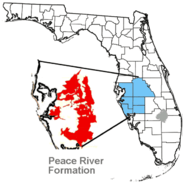Peace River Formation (Florida)
| Peace River Formation Stratigraphic range: Late Oligocene-Early Miocene | |
|---|---|
| Type | Geological formation |
| Unit of | Hawthorn Group |
| Sub-units | Bone Valley Member |
| Thickness | 600 feet |
| Lithology | |
| Primary | Sand, clay, carbonates |
| Other | Dolostone with phosphate, chert |
| Location | |
| Region | Central Florida |
| Country |
|
| Type section | |
| Named for | Peace River, Florida |

The Peace River Formation is a Late Oligocene to Early Miocene geologic formation in the west-central Florida peninsula.
Age
Period: Neogene
Epoch: Miocene to Pliocene
Faunal stage: Arikareean through Hemphillian ~23.03—4.9 mya, calculates to a period of 18.13 million years
Location
The Peace River Formation appears as an outcropping or is beneath a thin overburden from Hillsborough County to Charlotte County on the southern part of the Ocala Platform. extending into the Okeechobee Basin. It is widespread in Florida and part of the intermediate confining aquifer system.
Lithology
The formation is composed of sands, clays and carbonates which are interbedded. The sands are light gray to olive gray and poorly consolidated. They are clay-like with some dolostone with a very fine to medium grained phosphate component. Carbonates are usually light gray to yellowish dolostone found in outcroppings. The dolostones are soft to hard with variably sandy, clay-like, phosphate components with opaline chert often found. The phosphate content is high enough to warrant mining.[1][2]
Three sequences of sediment deposition were defined in 1998. Five lithofacies were identified in 2000 (upper part of the formation).[3]
- Diatomaceous mudstone
- Terrigenous mudstone
- Clay-rich quartz sand
- Quartz sand
- Pelecypod-rich quartz sand or sandstone
Fossils
- Mollusks occur as reworked casts, molds, and limited original shell material.
- Vertebrate fossils
- Shark’s teeth
- Silicified corals and wood
Members
The Bone Valley Member is a subunit of the Peace River Formation (originally the Bone Valley Formation) and occurs in a limited area on the southern part of the Ocala Platform in Hillsborough, Polk County, and Hardee County. (Webb & Crissinger). It is consistently clastic with sand-sized grains and larger grains of phosphate in a mixture of quartz sand, silt and clay. The consolidation is poor and colors range from white, light brown and yellowish gray to olive gray and blue green.[4]
See also
References
- ↑ USGS: Hawthorn Group, Peace River Formation, Bone Valley Member
- ↑ USGS: Geologic units in Hillsborough county, Florida
- ↑ Reese R.S., and Cunningham, K.J., 2000 (in press), Hydrogeology of the gray limestone aquifer in southern Florida: U.S. Geological Survey Water-Resources Investigations Report 99-4213.
- ↑ Florida Geologic Survey: Lithostratigraphic Units, Matson, G. C., Clapp, F. G. and Sanford, S., 1909, Geologic and topographic map of Florida; Contributing geologists: Matson, G. C., and Clapp, F. G., A preliminary report on the geology of Florida: Florida Geological Survey Second Annual Report, p. 23-173
- Finch, J., Geological essay on the Tertiary formation in America: American Journal of Science, v. 7, p. 31-43, 1823.
Further reading
- Berkenkotter, Richard D, Application of statistical analysis in evaluating bedded deposits of variable thickness—Florida phosphate data (United States. Bureau of Mines. Report of investigations, U.S. Dept. of the Interior, Bureau of Mines (1964)